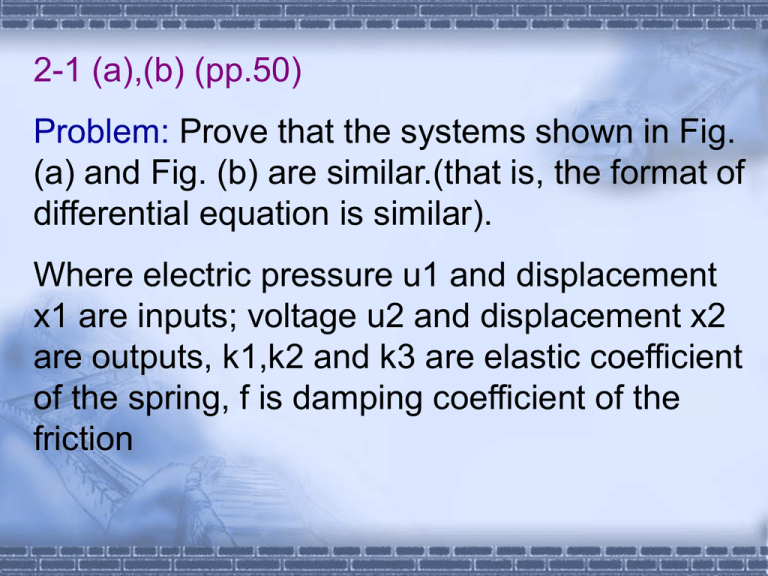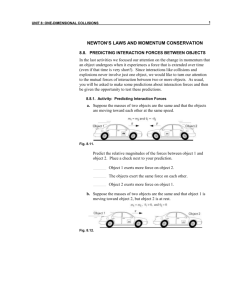1(t)
advertisement

2-1 (a),(b) (pp.50) Problem: Prove that the systems shown in Fig. (a) and Fig. (b) are similar.(that is, the format of differential equation is similar). Where electric pressure u1 and displacement x1 are inputs; voltage u2 and displacement x2 are outputs, k1,k2 and k3 are elastic coefficient of the spring, f is damping coefficient of the friction Fig. (a) Fig. (b) 2-3 (pp. 51) In pipeline ,the flux q through the valve is proportional to the square root of the pressure difference p, that is, q=K p . suppose that the system changes slightly around initial value of flux q0. Problem: Linearize the flux equation. 2-5 (pp. 51) Suppose that the system’s output is t c(t ) 1 e T under the step input r(t)=1(t) and zero initial condition. Problems: 1. Determine the system’s transfer function and the output response c(t) when r(t)=t, r (t ) (t ) 2. Sketch system response curve. 2-6 (pp. 51) Suppose that the system’s transfer function is C (s) 2 2 , and the initial R( s) s 3s 2 condition is c(0) 1, . c(0) 0 Problem: Determine the system’s unit step response c(t) . 2-13 (a), (d) (pp. 53) Problem: Determine the close loop transfer function of the system shown in the following figures, using Mason Formula. Fig. (a) Fig. (b) 3-2 (pp. 83) Suppose that the thermometer can be characterized by transfer function. C ( s) 1 R( s) Ts 1 Now measure the temperature of water in the container by thermometer. It needs one minute to show 98% of the actual temperature of water. Problem: Determine the time constant of thermometer. 3-4 (pp. 83) Suppose that the system’s unity step 60t 10t response is h(t ) 1 0.2e 1.2e Problem: (1) Solve the system’s close-loop transfer function. (2)Determine damp ratio and un-damped frequency wn . 3-5 (pp. 83) Suppose that the system’s unity step 1.2t h ( t ) 10[1 1.25 e sin(1.6t 53.1)] response is Problem: Determine the system’s overshoot % , peak time t p and setting time ts 3-8 (pp. 83) Suppose that unity step response of a second –order system is shown as follows. Problem: If the system is a unity feedback, try to determine the system’s open loop transfer function . 3-11 (pp. 84) Problem: Determine the stability of the systems described by the following characteristic equations,using Routh stability criterion. (1) (2) (3) s 3 8s 2 24s 100 0 s 3 8s 2 24s 200 0 3s 4 10s 3 5s 2 s 2 0 3-16 (pp. 16) Suppose that the open loop transfer function of the unity feedback system is described as follows. Problem: Determine the system’s steady2 t e state error ss when r(t)=1(t), t, respectively 100 G ( s ) (1) (0.1s 1)(0.5s 1) (2) 150( s 4) G(s) s ( s 10)( s 5) (3) 8(0.5s 1) G( s) 2 s (0.1s 1) 3-19 (a) (pp. 85) Problem: Determine the system’ steadystate error ess which is shown as follows. 4-2 (pp.108) The system’s open-loop transfer function is K. G( s) H ( s) ( s 1)( s 2)( s 4) Problem: Prove that the point s1=-1+j3 is in the root locus of this system, and determine the corresponding K. 4-4 (pp.109) A open-loop transfer function of unity feedback system is described as K G( s) s(1 0.02s)(1 0.01s) Problems : (1) Draw root locus of the system (2) Determine the value K when the system is critically stable. (3) Determine the value K when the system is critically damped. 4-7 (pp. 109) Consider a systems shown as follows: Where K (0.25s 1) G( s) s(1 0.5s) Problems: 1. Determine the range of K when the system has no overshoot, using locus method. 2. Analysis the effect of K on system’s dynamic performance. 4-10 (pp. 110) The open-loop transfer functions of unity feedback system are described as: 1/ 4( s a) (1) G ( s) 2 (a (0, ) s ( s 1) 2.6 (2) G( s) (T (0, ) s(1 0.1s)(1 Ts) Problem: Draw root locus with varying parameters being a and T respectively. 5-2 (1) (pp.166) A unity feedback system is shown as follows. Problem: Determine the system’s steadystate output C ss when input signal is r (t ) 2cos(2t 45 ) G(s) 5 s (5S 1) 2 5-7(3)(pp.167) Problem: Draw logarithm amplitude frequency asymptotic characteristics and logarithm phasefrequency characteristic of the following transfer function。 5 G(s) 2 s (5S 1) 5-8 (pp. 167) The logarithm amplitude frequency asymptotic characteristics of a minimum phase angle system is shown as follows. Problem: Determine the system’s open loop transfer function。 5-8(a) 5-8(b) 5-8(c) 5-8(d) 5-10 (pp. 168) The system’s open loop amplitude-phase curve is shown as follows,where P is the number of poles in right semi-plane of G(s)H(s). Problem: Determine the stability of the closeloop system。 5-10(a) 5-10(b) 5-10(c) 5-12(1),(2)(pp.168-169) The open loop transfer function of the unity feedback system is shown below: 100 1.G ( s ) s (0.2 s 1) 50 2. G ( s) (0.2 s 1)( s 2)( s 0.5) Problem: Determine the system’s stability using logarithm frequency stability criterion, the phase angle margin and amplitude margin of the steady system。





